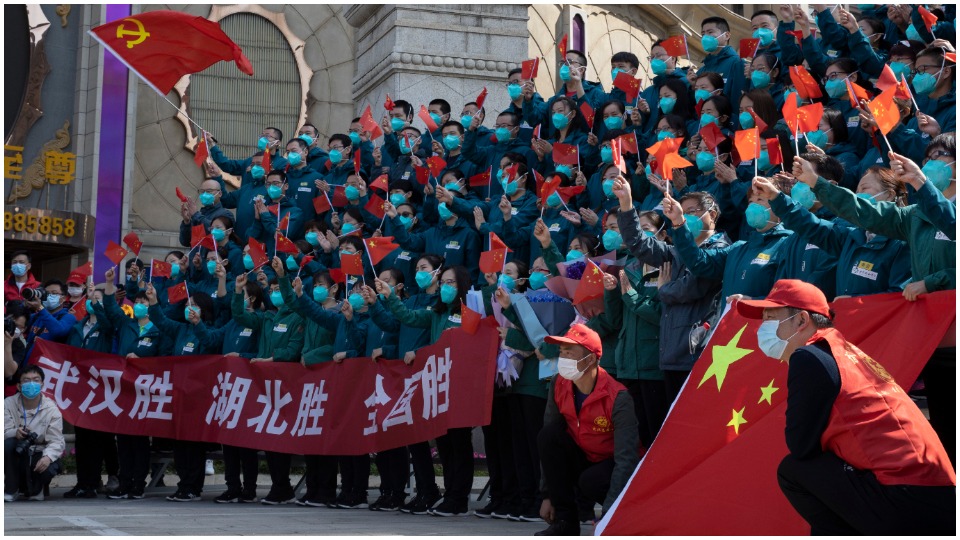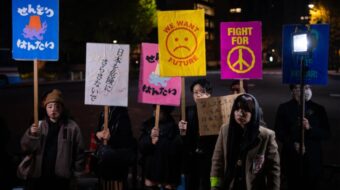
TORONTO—Nine months ago, in early February, People’s World interviewed Lupin, a 26-year-old man from Wuhan, China. At the time, his hometown was the epicenter of what scientists were still calling the “novel coronavirus,” a pneumonia-like illness which soon sparked a pandemic that engulfed the entire world. Lupin was working overseas in Canada but had returned home to Wuhan to visit family for Chinese New Year. His midnight flight on Jan. 23 was one of the last to land before the city was sealed in the world’s first coronavirus lockdown.
When I spoke with Lupin on the morning of Feb. 7, China had 31,000 confirmed infections and just over 600 deaths. The United States had only 11 known cases and zero deaths. That afternoon, President Donald Trump said that “as the weather starts to warm…the virus hopefully becomes weaker, and then gone.” It was only many months later we’d learn that on that very same day Trump told reporter Bob Woodward the truth about the virus—that it was “more deadly than even your strenuous flu.” Emphasizing the point he was hiding from the public, Trump said to Woodward, “This is deadly stuff.”
Wuhan was the only coronavirus quarantine zone then; its 11 million residents were the first in the world to experience the new stay-at-home normal. Government delivery of food and medical supplies helped people make it through the isolation, while emergency construction brigades raced to build temporary hospitals.
In mid-March, it was the West’s turn to enter lockdown, and PW checked in again with Lupin in Wuhan. International travel had come to a near-total halt, and Trump was already deflecting blame for what he was referring to in racist terms as the “China virus.” By that time, Lupin and his family had been sheltering in place for nearly two months. His father had lost a close friend to the virus, but a funeral service was impossible. “Many countries mocked the situation in China as if it will never become a ‘First World’ countries issue,” Lupin told me in March. “That arrogance,” he predicted, would become “a real obstacle.”
Unfortunately, his warning was proven completely accurate. Now, in mid-November, the United States stands poised to pass 250,000 deaths and has had over 11 million confirmed cases of COVID-19. The economy is in a depression, tens of millions of jobs are permanently gone, and countless businesses have gone belly up.
One of the few bright spots in the recent period—and it’s a big one—was the mass electoral uprising in the U.S. that issued Trump an eviction notice. He’s got to be out of the White House by Jan. 20th, but in the meantime, he still refuses to do anything to control the virus. Trump just kills time with frivolous election lawsuits while coronavirus kills over a thousand Americans a day.
But in Wuhan, the place where COVID first emerged late last year, Trump’s claim that the virus can’t be managed has been proven a lie. As the U.S. descends into a dark winter of mass death and economic hardship, for the people of Wuhan—and the whole of China—life is returning to normal. It’s actually already possible to speak of a post-COVID world, even as the fate of the West hinges on a vaccine that may be months away from widespread distribution.
Life after coronavirus
Just after Trump’s defeat in the U.S. election, I again spoke with Lupin about the situation in China and how life has changed for working people in Wuhan. When I caught up with him this time, he was actually back in Toronto, where he worked before going home to visit his mom and dad in January.

“Most Chinese cities were back to business as usual as early as April,” Lupin told me when I asked how things were different now compared to how they were at the time of our last conversation in March. He said he’s spent several months this year in different cities around China after Wuhan’s lockdown ended on April 8.
“People wear masks in transportation hubs and such…but they are out and about, public transportation is packed, and there are long line-ups at entertainment and dining facilities,” he said. “China’s people are trying to live as if COVID-19 never existed.” Many people in the United States are also trying to live as if it doesn’t exist. The difference, however, is that China has controlled the spread of the virus; the U.S. hasn’t even come close.
In Wuhan itself, Lupin said, the recovery has moved at a slower pace. “Many citizens were traumatized, and many businesses are closed permanently.” He observed largely empty streets well into May and June. “Many took their time to adjust mentally and to conquer the inner fear.” They were worried about a second wave and asymptomatic spread, but even in the place where coronavirus first appeared, life eventually caught up as time went by.
“Wuhan, like other cities, is back to normal now.” The most striking feature Lupin notices, he said, is the way that “people in Wuhan barely talk about COVID-19 anymore…. It’s as if they are determined to move on from this prolonged nightmare.”

Though Lupin and his family were spared infection, in addition to his dad’s close friend who passed, the father of one of Lupin’s friends also died. “He was the breadwinner for the entire family, and my friend couldn’t get a flight ticket to see his dad one last time.” Lupin’s friend was working outside China and was unable to return home in time before his father succumbed to the virus.
As for the economic costs inflicted by the pandemic, like everywhere else in the world, they were huge. The surveyed urban unemployment rate in China hovered around 5% all through 2019. With COVID-enforced shutdowns and layoffs, it hit a peak of 6.2% in February before declining back to 5.3% as of October. “There were certainly major job losses in the city,” Lupin said. The “real numbers” are hard to know, though. “These numbers are not necessarily ‘uplifting’ messages needed at the moment, so it’s not what the media prefer to report.”
Instead of direct benefit payments to individuals or families, the central government in China allocated billions of yuan to provincial governments for investment in locally-based companies. According to Lupin’s estimate, the government “believes this will outperform economically in the long run compared to giving cash to citizens directly.” Another reason for a macro-level strategy is that the government does not yet have in place an effective way to funnel payments directly to households, especially for the country’s tens of millions of migrant worker families. Stimulus checks like the $1,200 ones issued by the U.S. Congress were not immediately feasible in China.
Many unemployed workers and bankrupt business owners, therefore, continue to face a tough time as they wait for economic recovery, but at a national level, the government’s giant public investments are yielding results. A massive 3.6 trillion yuan ($500 billion) fiscal stimulus was passed in May, and after a contraction in the first quarter of the year, China is now on track to actually see year-on-year growth of around 2.4% for 2020.
While the economic analysis might show an uneven outcome so far, one area of policy that has been an undisputed success is the public health battle against the coronavirus. “The Chinese government’s handling was superb,” Lupin said without hesitation. “It took decisive action, and now everything is under control.” Looking back, he believes the government’s decision to shut down travel in and out of Wuhan and to actually enforce 14-day quarantines and contact tracing were key to stopping the virus in its tracks.

“Another thing that amazed me,” he observed, “has been China’s ability to test an entire city within a matter of days.” After one local case emerged in Qingdao, a city in Shandong province, the local government and Communist Party units “went door to door to test everyone.” The whole process “was done in two to three days, and the outbreak was stopped.”
Most new cases in China these days—and there are only a handful of them at any one time—are imported by international travelers. But measures are in place to try to stop that as well. People heading to China need a negative COVID-19 test and an antibody test before they are allowed to board a plane. Once they arrive in China, they are taken directly to a quarantine hotel for two weeks. “It’s a short-term pain for long-term gain,” Lupin reasons.
Return to Wuhan—and to safety
As mentioned, Lupin is currently back in Toronto, his home before COVID struck. But he won’t be here for long. Instead of resuming his work in Canada, he’s decided to return to China—permanently.
“I feel like every aspect of life in North America has been chipped away,” Lupin told me as he packed his old life into suitcases and boxes. “No gym, no dining out, face coverings everywhere you go, social distancing everywhere, and no jobs.” In Toronto, he feels like it’s impossible to escape COVID-19. “It’s like living with a chronic medical condition, and it doesn’t look like it’s going to change anytime soon.”
He’s resigned from his previous job and has already found a new one in China. He’s been working for months already, even as the economy continues to spiral down in the West. “I intend to reside in China for now, as the pandemic there is already water under the bridge.” There, he says, “the economy is back on track, and companies are hiring again.” Daily life for most people is essentially just as it was before 2020, and job prospects are certainly more promising.

It’s also a matter of safety. Lupin lived through the Wuhan lockdown from the first night it was mandated, saw people become sick and die, faced the barriers that come with crossing borders, took multiple coronavirus tests, spent weeks in a quarantine hotel, and watched as the rest of the world ignored the lessons Wuhan could teach about what it takes to beat the virus. To say the least, he’s over COVID-19.
The prospects for an end to the pandemic in North America anytime soon are, at best, unclear. There has been a wave of positive vaccine research news in recent days, but no one yet knows how quickly a vaccine will be made available to the general public. Basic preventive measures like mask-wearing and physical distancing continue to be politically charged, with the outgoing U.S. president and his coronavirus advisor, Scott Atlas, telling people just this week to “rise up” against public health officials. The situation is a complete disaster, and the new administration won’t take office until mid-January.
In the People’s Republic, by contrast, it’s already possible to plan for the future again. “I just want this episode to be over,” Lupin told me as he prepared to leave Toronto. “In China, it’s pretty much over.”
People’s World Wuhan Interview Series:
> Chinese national describes life inside the coronavirus quarantine zone
Wuhan resident: China “nationalized” coronavirus crisis; the West isn’t doing enough
Like free stuff? So do we. Here at People’s World, we believe strongly in the mission of keeping the labor and democratic movements informed so they are prepared for the struggle. But we need your help. While our content is free for readers (something we are proud of) it takes money — a lot of it — to produce and cover the stories you see in our pages. Only you, our readers and supporters, can keep us going. Only you can make sure we keep the news that matters free of paywalls and advertisements. If you enjoy reading People’s World and the stories we bring you, support our work by becoming a $5 monthly sustainer today.










